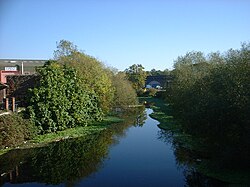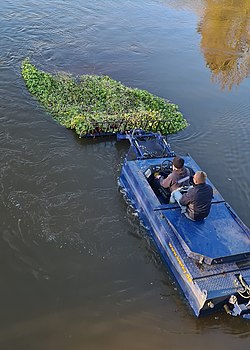| Hydrocotyle ranunculoides | |
|---|---|

| |
| Scientific classification | |
| Kingdom: | Plantae |
| Clade: | Tracheophytes |
| Clade: | Angiosperms |
| Clade: | Eudicots |
| Clade: | Asterids |
| Order: | Apiales |
| Family: | Araliaceae |
| Genus: | Hydrocotyle |
| Species: | H. ranunculoides |
| Binomial name | |
| Hydrocotyle ranunculoides L.f. | |


Hydrocotyle ranunculoides, known commonly as floating pennywort, or floating marshpennywort, is an aquatic plant in the family Apiaceae. It is native to North and South America.
Origin and invasiveness
Water pennywort is an aquatic plant, native to the Americas. Due to its popularity as a pond plant, and subsequent escape into rivers, it has established as an invasive alien species in parts of Europe, Australia, Africa and Japan. It was one of five aquatic plants which were banned from sale in the UK from April 2014, and was the first prohibition of its kind there. On the other hand, it is in decline in parts of its range in the United States.
In Europe, floating pennywort is included since 2016 in the list of Invasive Alien Species of Union concern (the Union list). This implies that this species cannot be imported, cultivated, transported, commercialized, planted, or intentionally released into the environment in the whole of the European Union.
Description
Water pennywort has stems that spread horizontally and can float on water. Leaves grow on petioles up to 35 cm long, and are round to kidney-shaped, with 3–7 lobes and crenate to entire margins. Flowers are small, pale greenish white to pale yellow, and come in umbels of 5–13. Fruits are small achenes that can float, helping the seeds to disperse.
The South American weevil Listronotus elongatus lays eggs on and eats the floating pennywort, and larvae also eat into the stems, reducing the pennywort's ability to grow. The weevil has been introduced for biocontrol of the floating pennywort into waterways in Britain, following extensive research to establish that the weevil is not a threat in itself.
References
- "Hydrocotyle ranunculoides (floating pennywort)". Invasive Species Compendium. Retrieved 3 February 2021.
- "Invasive non-native species - indicator two". Environment Agency. Archived from the original on 13 May 2010. Retrieved 28 August 2017.
- "Aquatic invaders threat to biodiversity". The Ecologist. Retrieved 2017-08-28.
- Kinver, Mark (2013-01-29). "UK bans sale of five invasive non-native aquatic plants". BBC News. Retrieved 2017-08-28.
- "Plants Profile for Hydrocotyle ranunculoides (floating marshpennywort)". USDA, NRCS. 2021. The PLANTS Database. National Plant Data Team, Greensboro, NC 27401-4901 USA. Retrieved 2021-02-03.
- "List of Invasive Alien Species of Union concern - Environment - European Commission". ec.europa.eu. Retrieved 2021-07-27.
- "REGULATION (EU) No 1143/2014 of the European parliament and of the council of 22 October 2014 on the prevention and management of the introduction and spread of invasive alien species".
- ^ John, Hilty. "Water Pennywort". Illinois Wildflowers. Retrieved 16 December 2012.
- "H. ranunculoides". Jepson Manual. University of California. Retrieved 16 December 2012.
- Horton, Helena (17 May 2022). "South American weevils released in UK waterways to tackle invasive weed". The Guardian.
| Taxon identifiers | |
|---|---|
| Hydrocotyle ranunculoides |
|
This Araliaceae article is a stub. You can help Misplaced Pages by expanding it. |